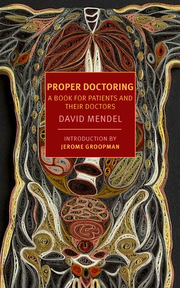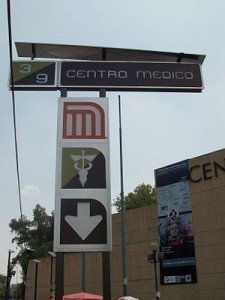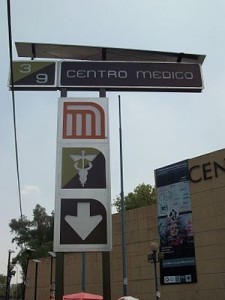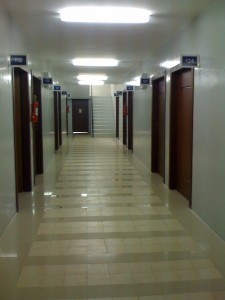Zackary Sholem Berger's Blog, page 20
August 29, 2013
Wide-angled listening and the democratization of medical knowledge
Cross-posted bookward.
The publisher NYRB Classics kindly sent me their reissue of David Mandel’s Proper Doctoring: A Book for Patients and Their Doctors. It’s full of sharp, opportune musings – based on fact and experience, and some curmudgeonly ideology – on the value of deliberation, kindness, and wide-angled listening in the care of human beings. I look forward to tweeting and blogging about it in the days ahead.
I am reading the introduction, now, and other thoughts came to mind, provoked by the introduction of Jerome Groopman:
Over the course of their careers, physicians build a library. During the early years of medical school, they acquire foundational textbooks[. ...] Later, in their cinical training, they add tomes on internal medicine, pediatrics, surgery, [etc.] If they pursue a specialty, doctors complete their collection with volumes from that field. …
Not controversial, but what struck me was the obvious presence of books, qua books, in Groopman’s medical education – while they really haven’t played that much of a role in mine. Sure, there was always the much-venerated but little-read Harrisons glowering down at me from a distant shelf; and the strictly utilitarian test-prep books I will no doubt buy again when I retake the internal medicine boards in fewer years than I would like to admit.
But books? Bound paper? No, we’re all about the quick fix. The UpToDate lookup. The guilty Googling of a symptom cluster. The email to a colleague.
If this anecdotal experience is correct, then I can see two implications to be drawn. One is false – the assumption I tried to slip by just a paragraph ago. No, we are not into the quick fix. There is plenty of depth in written medicine today, from lengthy think pieces in Theoretical Medicine and Bioethics, to essays in JAMA or New England Journal, to deeply researched aticles for the lay public in The New York Times Magazine. And if you want long articles dense with empirical medical data, the Annals of Internal Medicine is your beach read.
The other implication one can draw, I think, is absolutely true, and revolutionary, and heart-stoppingly scary if you are a doctor. With the freeing of words from the page comes a promise of democratized knowledge. Perhaps I am naive, and the Evgeny Morozovos of healthcare are giggling at me as they read these words. Think of it though: would any doctor have read a patient’s musings 20 years ago? Now I do it all the time.
Where does scientific medicine stand on all this? Is it asleep in a tent on shifting sands? Who gets to decide what empirical knowledge is – especially when so-called professional guidelines are susceptible to their own biases?
Perhaps we should use this democratizing opportunity for patients and providers, together, to make their own evidence-based guidelines for treatment. Wipe the slate clean and start over.
What do you think?
August 28, 2013
All the decisions are made somewhere else: observations made while working in the hospital
Most of the time I take care of patients in the clinic, but I regularly admit patients to the hospital as well. I try and notice what makes me uncomfortable when I see them there. (Which is probably not as completely or acutely noticed by me as by the patient – but, hey, you take what you can get on this blog. Obviously, there are no shortage of patient blogs to read as well.)
No one knows anything. The attending – me – doesn’t know discharge time because it depends on when the meds are filled and the appointments are made. The patient doesn’t know their discharge time because they are under the mistaken impression the exact time is up to me.
Decisions are made elsewhere. The patient’s wife, who is on top of things and asks impressively detailed questions which have improved care for her husband, asks what a certain specialty service is going to do about a procedure. I don’t know, and I’ll ask them. But any decisions they make are not going to be done in the room, while talking to the patient and his wife. They’ll be made in some corridor somewhere, and then transmitted to me by page or phone. Everything gets to the patient and their family third-hand.
The endpoint isn’t clear. We try to identify, at the beginning of the admission, what is the goal for discharge, but when the active issues change, as they have many times in this case, the patient can find themselves in the hospital for longer than they had expected.
Outpatient versus inpatient. The patient is understandably concerned about missing the clinic appointments he can’t keep because he’s cooped up here in the hospital. He wants to know if those services can come by. No, I start to say, by instinct, because they deal in the hospital with urgent or severe matters. But then I thought: couldn’t we do it that way after all? We do counsel smoking cessation, and do other preventive services or counseling, for patients who might not get them any other way.
An esteemed senior physician who I knew in New York says that every patient is an opportunity to do research, i.e. learn about the course of disease. Whenever I see a patient in the hospital, it feels like health services research in miniature. This is what the hospital is like: bewildering, inefficient, and at cross-purposes with itself.
No false modesty here: we have a great team, and the gentleman is getting better! Not without, though, teaching us important lessons in efficiency, patient-centeredness, and humility.
August 27, 2013
How to communicate with your doctor: ideas and preparations
If you don’t have access to a doctor who speaks your language, make sure that the interpreter has experience in working with patients like you.
Avoid using a family member as an interpreter.

Although the time of the visit is limited, you can use mindfulness techniques (detailed in the book) and take advantage of the entirety of each minute.
Realize that neither doctors nor patients know everything – and for that reason a relationship between the two can achieve health. Both play an important role.
Recognize and admit the place of emotions in the visit, both of the patient and the doctor, and take advantage of them.
Prepare for the visit with a narrative of your symptoms.
Recognize hat you aren’t going to be comfortable discussing you most intimate symptoms, but it’s necesary to talk about them anyway. Without openness, what point is the medical visit, and how can a healthy relationship be established between you and your provider?
Invest in the relationship with your doctor. You won’t agree on every point, but little by little you can establish compromise and work together.
Como comunicarse con el médico: ideas y preparaciones
Asegure que tenga acceso a servicios de salud en su idioma y, cuando necesario, un intérprete según la ley. (Cada clínica que proporciona servicios Medicare o Medicaid debe ofrecer un intérprete en su idioma.)

Si no tiene acceso al médico hispanohablante, asegure que el intérprete sea bien practicado en el trabajo con pacientes como usted – es decir, con tal idioma que Ud. entiende, y con experiencia en hablar sobre las enfermedades de que Ud. padece.
Evite utilizar a un pariente como un intérprete.
Aunque el tiempo de la visita sea limitado, pruebe usar las técnicas de la atención (mindfulness) y aprovechar cada minuto por entero.
Hay que darse cuenta de que ni los doctores, ni los pacientes saben todo – y por eso una relación entre las dos puede lograr la salud integral. Ambos desempeñan un papel esencial.
Hay que reconocer y admitir el lugar de las emociones en la visita, del paciente y del médico, y aprovechárselas.
Prepárese para la visita con una narración de sus síntomas.
Reconozca que a Ud. no le va a ser cómodo discutir todos sus síntomas más íntimos – pero de todos modos es necesario. Sin franqueza y sinceridad, ¿qué sentido tiene la visita, y como se puede establecer una relación útil y sensitiva entre paciente y medico?
Invierta en la relación con su médico – Uds. no van a estar de acuerdo en toda decisión o discusión, pero poco a poco se puede establecer un compromiso durante tiempo.
August 26, 2013
The health care system’s Yom Kippur confessional, from A to Z
Crossposted at Talking To Your Doctor.
I don’t talk too much in the pages of Talking To Your Doctor about my own personal religious or cultural allegiances. Good health care, as I mention in the book, is the application of universal principles to infinitely variable patients. Doctors’ characteristics are inherently less interesting (to my mind) than those of the multifarious people they try and help. Still and all, we are now in the days leading up to the High Holidays of the Jewish calendar, when – as Jewish myths have it – the world was created. In that tradition, this is the month where we try to surprise ourselves into realizations of how imperfect we have been. It is the time not to take any flaw for granted anymore.
Since much of this blog has to do with our system’s flaws, I thought I would present an attempt at secular liturgy. The Yom Kippur prayers involve many acrostics meant to catalog our imperfections. Why not do the same thing with our health care system? If sometimes it gets awkward making problems fit into the alphabet, it’s no more awkward than being a patient that has to go through such a system.
We should not ask forgiveness, but change our health care system that
accepts inequality as a matter of course;
breaks hearts callously;
computerizes without deliberation;
deliberately popularizes without evidence;
ever specializes;
familiarizes us with inefficiency;
grabs the most expensive thing off the shelf;
hates difference;
innovates technologically but not ideologically;
jeers at the addict;
kills;
lies;
medicalizes personality differences;
never says sorry;
often dissembles;
pays whatever is asked without question;
questions patients more than providers;
rashly introduces new treatments;
shies away from community engagement;
treats the poor with disdain;
understands little;
very little;
wears the mantle of science without justification;
excels in profligacy
yet cannot manage equity.
Zack Berger
August 23, 2013
The autism “center of excellence”?: a mother’s experiences in two acts
A guest post by Cari Noga.
Act I, Scene I
We are aiming toy trucks down the shiny hospital hallway at our recalcitrant seven-year-old autistic son, attempting to lure him from the waiting room to the doctor’s office. Another doctor is on deck. Then a speech therapist. Between each, waiting room time. That’s five transitions between providers.
And that’s on top of the disruption to his routine forced on him in the first place. It’s a Thursday, a school day. But before it will approve the treatment we want, our insurer requires us to travel to this autism “center of excellence” 150 miles from home to obtain a redundant diagnosis.
Together with social and communication impairments, reliance on routine and intolerance for transition are hallmarks of autism. We could have been placed in an exam room and the providers brought to us. The circumstances of the appointment are completely counter to what’s optimal for the patient, whose anxiety is now at fever pitch. This is excellence?
Act I, Scene II
I return the hospital’s customer survey with negative answers. I call the Patient Relations Coordinator and leave a message, unreturned. Finally, we talk. Afterward, I receive a letter accurately summarizing the conversation and my two chief recommendations. In addition to the transitions between providers, we were told to bring his records. Thus, no one knew anything about our son’s history until he was standing there. Redundant questions and inefficiency ensued, made worse by the stress of the transitions. My radical solution? Request the records ahead of time.
The letter says my feedback has been forwarded to “program leadership for review and follow up.” It is signed by an RN. Feeling better that someone with actual clinical experience is handling patient relations, I file the letter and move on.
Act II, six months later
Autism parent support group meeting. A new man is there, actually a grandparent. He mentions they sought a diagnosis for his grandson at the same facility we did. Did they go from doctor to doctor, or stay in one place? Doctor to doctor, he says, adding they also brought a three-inch stack of medical records. Cue sigh.
I still have the contact information from the RN Patient Relations Coordinator. Maybe program leadership did review my feedback and discarded it. And would you like to buy a bridge to go with that delusion? No, they kept on keeping on the way it was set up, in their best interest instead of patients.
So why do I bother trying to communicate at all? We got the diagnosis we came for. It’s over.
Because I keep thinking about that next child. That two- or four- or five- or eight-year-old who, like my son, will lie on the floor next to the elevators and simply refuse to move. Who will cry and shriek and carry on as their parents slide cars at them. Whose anxiety will soar needlessly. Whose parents’ hearts will break, wondering whether it’s worth it.
Act III, Act IV, Act V don’t have to play out, ad infinitum. It’s not just bureaucratic. It’s tragic.
Cari Noga is the mother of a seven-year-old son with autism and the author of Sparrow Migrations, a novel about a 12-year-old autistic boy who becomes obsessed with birds after witnessing the Miracle on the Hudson plane crash. She lives in northern Michiganand blogs at www.carinoga.com.
August 22, 2013
“Why don’t you leave our [expletive] hospital?”: Is professionalism or true emotion the right response to naked racism?
Cross-posted to the blog at Talking To Your Doctor.
A recent article in the academic journal Annals of Internal Medicine has given rise to a lively exchange of letters. The article, entitled The Racist Patient, touches on some issues many would prefer to ignore. Here’s the start of the piece by Sachin H. Jain, MD, curently at the Boston Veterans Affairs Medical Center in West Roxbury, Massachusetts:
In my final months of residency, I was summoned to see an angry patient. Mr. R. was furious that our pharmacy did not stock his brand of insulin. He wanted to issue a complaint.
“You guys always mess up my insulin whenever I am here. I told the other doctor, and now I’m telling you. You guys just can’t get it right.”
“I’m sorry,” I told him. “If you prefer, your family can bring your insulin from home and our nurses can administer it. Would that be an acceptable solution?”
“You people are so incompetent.”
Uncertain of how I might best diffuse the situation, I looked uncomfortably in the direction of my patient’s son, who was seated at the bedside.
“You look at me when I talk to you,” Mr. R. commanded. “Don’t you look at him.”
“I’m sorry. Why don’t I come back later?”
As I uncomfortably walked out of the room, he launched a grenade.
“Why don’t you go back to India!”
On pure instinct, I responded, “Why don’t you leave our [expletive] hospital?” To underscore my point, I repeated myself.
I exited the room in a cold sweat.
In a later issue of the Annals, letter-writers shared various ideas about how one might best react in that situation. “[In a similar situation], my personal feelings were immaterial [to the proper treatment of the patient],” said a Dr. Galishoff of Alabama, who had experienced anti-Semitism. Dr. Sahai, of Houston, Texas, who identifies himself as a physician of Indian descent who has faced similar remarks, says, “I have never lost my cool in the presence of the patient.”
Even Dr. Jain himself wrote a letter of response to “clarify misconceptions.” He protests, “I am in no way proud of how I reacted to [the patient's] incendiary comments.”
This is where I depart from the opinions already expressed, though I should take pains to point out that I would never, I hope, make a remark like Dr. Jain’s even if faced with such an obnoxious patient.
My point is this: sometimes professionalism is too weak a vessel to contain our very real human feelings and emotions in stressful situations. I am not sure how Dr. Jain should otherwise best have expressed his displeasure in a way that conveyed the extent of his hurt. I agree that a strongly worded letter, composed later with due deliberation, would be an ideal response in tune with the spirit of professionalism. But this does not change the fact of emotions: when we are angry, we get angry, and we respond.
What better way – as a human being, not just as a physician – to express how horrified we are at naked racism than to call out the person who launched, as the author put it, that grenade? Curses are a powerful expression of injury, and were Dr. Jain to have confined himself to a letter, or the pallid adjective “appropriate,” the patient might not have learned anything at all.
Cursing at patients is not part and parcel of professionalism, and I hope I would never do so. But – then again – I hope I would never be the target of such a racist remark. Sometimes, our human feelings burn through the veneer of professionalism and we are left as insulted as anyone.
Have you ever had a sensitive or offensive exchange with a doctor or patient? How did you react?
August 21, 2013
Knowing the body
Cross-posted you know where.
We hear it all the time as doctors, and we say it a lot as patients: “I know my own body.” There are many layers packed into that one phrase.
I have my own integrity as a person. You, doctor, with your knowledge: wonderful, but you must recognize my independent existence, needs and wants.
I am unique. Indeed, you, doctor, know the ways in which a particular disease commonly presents itself. But I still can teach you things about the way my body reacts.
I am the expert about me. You can tell me the ways I should react to interventions, but only I have direct and unmediated access to my senses.
Take these facts into account, and remember: in general physiology, you might be an expert. But in the particular physiology of myself (says the patient, say us) we are awarded a doctorate every single day of our lives.
August 19, 2013
Breaking out of the closed-ended history
Cross-posted to the blog at Talking To Your Doctor.
Switching to a new electronic medical record provides the opportunity, or the burden, of re-entering all information concerning the family and medical histories — and to think about what the use of these might be.
One reason, of course, is to ascertain what facts in the medical history might predict a greater risk of health problems later in life, or be useful to diagnose a current problem, or response to therapy. If our medical history is understood this way, then by extension, our family’s medical history is just a way of getting more information about what might happen to us in the future.
But of course the medical history is more than just a series of checkboxes to figure out which conditions can be entered into a predictive risk calculator. It is another way of referring to the entire experience of illness from our (the patient’s) perspective.
This goes back to a larger theme that I have discussed here (and in the book) time and time again, the difference between the open-ended and the closed conversation. The closed conversation is meant to collect information that the doctor (or whoever) is sure a priori should be elicited. The open-ended conversation, on the other hand, can turn into something that neither party expected. The doctor might found out that she has more in common with the patient than she thought. And vice versa.
A patient of mine with chronic pain, in her 70s, sees me every month, and to tell the truth I usually focus on the specific markers, both physical and pathological, or her multiple diseases. Until she was hospitalized recently, I never knew that she had served in the military a couple of decades ago, and in that capacity had traveled around the world. She has much to tell, and I never realized it.
Will this cure her pain? No. But I hope with this piece of information, and, ideally, both me and her attuned to the opportunities afforded by it, we will break out of the cycle of test-treat-test-treat frustration which so often hobbles us, especially for chronic conditions where fallacy of a single solution is misleading and often harmful.
August 16, 2013
Consuming passions
I was invited by an organization to coordinate a Twitter chat about customer responsiveness. A lovely invite indeed, though I couldn’t take advantage of it.
In thinking about the substance of the invitation, I returned to a theme which has been a much-discussed topic lately. Are patients consumers?
Some people try to say yes to that question out of a commendable instinct. If we sell cars, or even more if we make them, we want to make sure that the person who pays money for them gets the absolute best automobile possible. It’s common sense, and ethical practice: producing well-made goods can help society and the individual. A consumer is worthy of respect for that reason, since she participates in an age-old relation.
But a patient is something different. Etymologically, a patient is a suffering person. Take away the suffering for a moment: a patient is a person, full stop Every person, no matter who they are, experiences suffering.
Pain involves the whole person; suffering threatens the very foundations of our selves. Being with the patient – the suffering person – at that moment is radical empathy, sacrificing some of the surety of our existence to make sure someone can live in wholeness.
In health care, in redressing health, we are trying to do the opposite of consume. We are attempting to achieve wholeness in the midst of suffering.
So, no. We don’t want consumption. We want restoration. For lack of a better word: healing is what we seek.



